STEPHENIE MEYER
Ms. Meyer sent 15 query letters about her teenage-vampire saga. She got nearly 10 rejection letters; one even arrived after she signed with an agent and received a three-book deal from Little, Brown. She doesn’t need to send out query letters anymore.
The Death of the Slush Pile
Even in the Web era, getting in the door is tougher than ever
Wall Street Journal January 22, 2010 by Katerine Rosman
Katerine Rosman, discusses the plight of Hollywood studios and publishers having to defend themselves from writers who want to sue, because the studio or publisher, released a similar story as something a writer sent in through the slush pile. A Random House editor said she hadn’t found anything in the slush pile since 1991. Thus the reason Katerine says…
Slush is dead, or close to extinction.
Film and television producers won’t read anything not certified by an agent because producers are afraid of being accused of stealing ideas and material. Most book publishers have stopped accepting book proposals that are not submitted by agents. Publishers say they can scarcely afford the manpower to cull through the piles looking for the Next Big Thing.
As writers try to find an agent—a feat harder than ever to accomplish in the wake of agency consolidations and layoffs—the slush pile has been transferred from the floor of the editor’s office to the attaché cases of representatives who can broker introductions to publishing, TV and film executives. The result is a shift in taste-making power onto such agents, managers and attorneys. Theirs are now often the first eyes to make a call on what material will land on bookshelves, television sets and movie screen.
Still, discoveries do happen at agencies, including the biggest publishing franchise since “Harry Potter”—even though it basically took a mistake to come together. In 2003, an unknown writer named Stephenie Meyer sent a letter to the Writers House agency asking if someone might be interested in reading a 130,000-word manuscript about teenage vampires. The letter should have been thrown out: an assistant whose job, in part, was to weed through the more than 100 such letters each month, didn’t realize that agents mostly expected young adult fiction to weigh in at 40,000 to 60,000 words. She contacted Ms. Meyer and ultimately asked that she send her manuscript.
The manuscript was passed on to an agent, Jodi Reamer. She liked what she read, a novel called “Twilight.” She signed Ms. Meyer, and sold the book to Little, Brown. The most recent sequel in the series, “Breaking Dawn,” sold 1.3 million copies the day it went on sale in August 2008. The latest film grossed more than $288 million in the U.S.
At William Morris Endeavor Entertainment, Adriana Alberghetti only reads scripts sent to her by producers, managers and lawyers whose taste she knows and trusts. The agent says she receives 30 unsolicited e-mails a day from writers and people she doesn’t know who are pushing unknown writers, and she hits “delete” without opening. These days, she is taking on few “baby writers,” she says, adding that risks she would have taken five years ago she won’t today. “I’ll take very few shots on a new voice. It’s tough out there right now,” she says.
Book publishers say it is now too expensive to pay employees to read slush that rarely is worthy of publication. At Simon &
 Today, The Muffin welcomes Wolf Hoelscher, owner of a new company to help writers and editors connect called Pubmission. We interviewed Wolf to find out all the ins and outs of Pubmission--a website designed to make the process of submitting manuscripts easier for both writers and publishers.
Today, The Muffin welcomes Wolf Hoelscher, owner of a new company to help writers and editors connect called Pubmission. We interviewed Wolf to find out all the ins and outs of Pubmission--a website designed to make the process of submitting manuscripts easier for both writers and publishers.
WOW: Welcome, Wolf, thanks for taking the time to chat with us today. What is the purpose of Pubmission?
Wolf: The purpose is simply to make the submission process easier for both publishing professionals and writers. Just as Monster.com or CareerBuilder attempts to connect job seekers with employers, Pubmission’s goal is to serve as a central hub for submissions that helps writers and publishers find each other in a simple, less intimidating way. From a writer’s perspective, it takes a long time to hunt through the listing manuals to find the right publisher. On Pubmission, writers can see which subscribing publishers match up with them best. And then they can go ahead and submit to them directly through the site.
There’s been a lot of talk about the death of the slush pile now that e-books and self-publishing are moving to the forefront of the industry. I don’t believe it has to be that way. As a writer myself, I know that it feels like you’re playing the lottery when you submit your work. It’s frustrating and daunting. But traditional publishers and agents still have a lot to offer writers, particularly in terms of editing and marketing. The slush pile isn’t dead; it’s just that the system is cumbersome and time-consuming. Pubmission attempts to rectify that.
WOW: What a great idea--anything to make the process of submitting our work easier is genius! How can writers benefit by using Pubmission?
Wolf: First, let me say that we try to make very clear to writers that Pubmission does not guarantee publication. If your writing isn’t fantastic, polished, and marketable, your chances of finding a publisher are slim. As a writer myself, I know that submitting your work can feel like buying a lottery ticket. But in this Internet age, there are tools out there that can help you prepare and market your submission in ways we never thought possible before. Pubmission is one of those tools.
We try to help writers with their homework. Slush pile editors are often frustrated because many of the writers who submit to them aren’t familiar with their publication and send them inappropriate work. But on Pubmission, not only do we list the guidelines and company info for each publisher, we also show writers which publishers have needs that pair up with the genre and tags associated with each submission.
So as a writer, you can send your submission directly to the publishers you like, and you can submit it to the General Database [on Pubmission], where any subscribing publisher has the ability to search for it.
There are also things you can do to improve your submission’s visibility. Editor Ratings not only show publishers a star rating based on an editor’s appraisal of its saleability, but each comes with a short critique that can give a writer an unbiased second opinion. We’re also adding a page that will show you how your rating matches up with other submission ratings on the site per
Last month, on my first day of work as an editorial intern here at Albert Whitman, I walked into the office anxiously wracking my brain: What was that word all the editors used during my interview? Slurp? Slug? Mush? Oh, that’s it:
SLUSH
Slush is, as I have come to learn, what people in the publishing biz call the mountains of unsolicited manuscripts that the editors read and, maybe, decide to publish. We receive over 5,000 manuscripts every year and each one contributes to the collective slush. But maybe, this is one of those phenomena that only a picture can really describe:
While the editors are always chiseling away at the slush pile, taking on chunks when they can find time, sometimes it is necessary to wage a full scale attack on the pile: you have a slush party. A slush party, to strain the metaphor to its breaking point, is the surge in the war against mountains of slush. Equipped with boxes of slush, letter openers, and cookies, we did some serious damage, two whole boxes of manuscripts: sorted into submissions that weren’t right for us and others that intrigued us. Victory tasted sweet, sort of like oatmeal raisin cookies.
Every time I confront the slush pile, I am amazed and humbled by the number of manuscripts. Apparently, people of all ages, from all over the place, and of all different walks of life, want to connect with and educate children through their stories. For me, a college student trying to figure out where I want to fit in the worlds of literature and education, it is really inspiring.
So keep the submissions coming. Don’t worry; we can take anything you throw at us. We’ve got a secret weapon: the slush party.






Revision update: Another two chapters revised in the last two days, but I’m starting to doubt that I’ll finish by the end of the week. Maybe end of next week?
For unpublished writers, facing the slush pile can seem daunting. We hear all these horror stories about manuscripts getting buried in six-foot piles of paper, never to be heard from again. We send off query letters filled with hopes and dreams and fear they’ll get lost in a sea of other queries.
The slush pile has changed a lot in the last few years. It used to be stacks and stacks of manuscripts in an editor’s office, but that has — mostly — gone now. In its article Death of the Slush Pile, the Wall Street Journal offers up some of the well-known authors who were discovered through the slush pile when it was in its heyday, such as Anne Frank. If it wasn’t for the slush pile, we wouldn’t have her classic literary work, which is a staple of English class curriculums.
But what WSJ’s Katherine Rosman doesn’t point out is that it’s not so much that the slush pile has died, it has just changed. Today, most publishing houses won’t accept unsolicited manuscripts except from agents. So the slush pile has moved from the editor’s desk to the agent’s desk, and for most agents, it has moved from paper to electronic. This newest technological change benefits both agents and writers. When I sent out my first query letter for my first novel, within minutes I had a request for the full manuscript. Not every agent was so quick, but on average, I’d say the turnaround time was around a week between query and response. (It was longer after a full was requested, but that’s a lot more reading on the part of the agent.) A week is a lot different from the three-to-six-month turnaround time — at least — when writers and agents/editors were dealing with paper copies.
Rosman does point out one agent slush pile success: Stephenie Meyer. But agents will tell you there are many others.
Here’s the latest example: Earlier this month, agent Janet Reid wrote about the launch of her client Patrick Lee’s book and how that book came to her as a query in her slush pile back in August 2007.
And on the Guide to Literary Agents blog, agent Ted Malawer told how he found his client Sydney Salter through her stellar query letter in his agency’s slush pile.
These are just two examples, but it shows that, with a brilliant query letter and an equally brilliant manuscript, slush can in fact work.
Hang in there.
Write On!



![]()
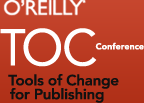 This week, leading-edge technologists, social media gurus and publishers discussed the future of publishing at the O’Reilly Tools for Change for Publishing conference.
This week, leading-edge technologists, social media gurus and publishers discussed the future of publishing at the O’Reilly Tools for Change for Publishing conference.
I just read a wrap-up from Publishing Trends that blew my mind. Chris Brogan, President of New Marketing Labs, suggested that publishers put their slush piles online, as a way to determine if the public would want to read it before it gets published (or rejected)!
Brogan also said that “Twitter is THE social media tool publishers should learn how to use…it’s a better marketing tool than MySpace or Facebook.” Why? It encourages discussion and allowers users to develop genuine relationships.
The publishing industry has to be very careful that books don’t go the way of music before they’re ready for it. Can you imagine a Napster for literature? The Kindle 2 was just released–and its sleeker, magazine-slim design is appealing (there’s a waiting list). Publishers must embrace technology now, before clever programmers enable the public to make their own decisions about how they’ll purchase books.
I’m eager for your thoughts. What do you think about social media and publishing? How will it change the game?






Authonomy is an online literary community service provided by HarperCollins Publishers that allows you to share, review and promote your writing. This term of use agreement (‘agreement’) contains the legally binding terms for your use of the Website http://www.authonomy.com/.
"...the idea of making the slush pile public and asking the people in the slush to determine which manuscripts are worth reading sounded to me like asking the guy with one leg and three fingers about how to use a chain saw." Editorial Anonymous
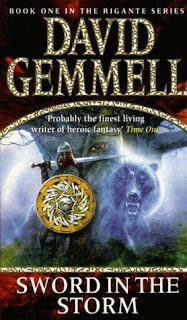
Sword in the Storm by David Gemmell is book one in the Rigante series. It's also one of the reasons I started the Cardathon. Let me explain. Yes, I started the Cardathon to introduce others to the glory-that-is Orson Scott Card. But it was also selfish. I wanted the chance to read some books that were Card-recommended. I would read Card's essays/articles about the books he was reading and be intrigued, curious. Card's thoughts on Gemmell intrigued me. Here is an author--Gemmell--that I've never heard of. And Card is praising him enthusiastically. You can read his review of David Gemmell's Rigante series here. I knew immediately that I would want to read some to experience it for myself--to see if it was really as good as Card claimed.
Sword in the Storm is 439 pages of pure pleasure. It's historical fantasy. But--and this is purely my take on it--it is fantasy that is done in such a way that it doesn't feel like fantasy. It feels real. The world is so well-crafted, so well-grounded. The characters so human, so life-like. It just feels real. Yes, there are some magical powers going on. (The Seidh) (Especially crucial is the Morrigan. Though I think the spelling may be altered in the novel.) But they feel real. They don't feel like make believe. It was a world, a time and place, that I thoroughly bought into.
The first book--the only book I've read so far--follows the life of a tribe--the Rigantes--based on the Celts of Britain. They never say the word "Britain." And the closest you get to "celt" is "Keltoi" but when you read it there is little doubt where it is set. Similarly, the threat--the people, the soldiers, of "Stone" are never called "Romans." But the reader knows who the soon-to-be enemies/conquerors are.
Never has a book been so rich, so fully immersed in culture WHILE at the same time being so full of action and intensity. The characters are well-developed. It doesn't matter if they're major or minor. All the characters have a life, a spark of their own. Each plays a role in the drama. Each is important. The whole community--the whole tribe--is given life. His characters are so human, so believable. They're full of flaws, but they're still--for the most part--so likable. You understand them. If they do good. If they do bad. You feel you know why. You understand why. The action? Intense. Whether plotting a romance or preparing for great battle scenes, the pacing is unbelievable. All of it is so good. It really keeps the pages turning.
I think I will take a hint from Card and not talk too much about the characters themselves. This is one you need to read for yourself.
I have actually said nothing about the characters themselves. For good reason: I don't want to mar them by trying to summarize who they are.
For Gemmell has done something that is rarely attempted outside the fantasy genre and rarely done well within it. He has created characters of nobility and honor, and has done it so well that instead of seeming larger than life, they never lose their humanity.
Anyway, I can't recommend this one highly enough!!!! Read this book!
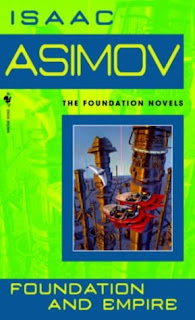
Foundation and Empire by Isaac Asimov was originally the second in a trilogy of novels. First published in 1952, the novel is in fact two stories or two novellas originally published (separately) in 1945.
Things you should know:
*Foundation was good. Really good. But Foundation and Empire was even better.
*Foundation and Empire is infinitely better than Prelude to Foundation.
*While I would certainly recommend reading Foundation, I think you could pick up Foundation and Empire without having read the other and still appreciate it for the great book that it is. It does in fact include a nice two page summary of the novel Foundation.
*Foundation and Empire has a certain something-special about it that makes it stand apart from Foundation. The writing seems wittier, funnier, more tongue-in-cheek. There's just something about it that makes it pop.
I am still operating under the philosophy of sometimes it is better not to know, BUT at the same time I don't want to be accused of not "reviewing" it properly.
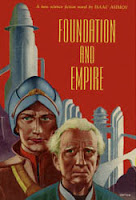 Foundation and Empire roughly picks up about three hundred years after Foundation opens. In the first novella, "The General" the reader learns of the fourth (I believe it's fourth) Seldon crisis. One of the strongest generals of the Empire (what remains of the Empire) is out to destroy the Foundation. Bel Riose is the general's name. Ducem Barr, the son of a man we met briefly in Foundation, is a main character--a character that opposes the Empire even at great risk to his own life and his own family. Lathan Devers, a trader, is also of importance. The plot of "The General" is relatively simple, and this is the shorter of the two stories. In the second novella, "The Mule" the Foundation faces its GREATEST threat so far. It begins simply with the homecoming of a bride and groom. Bayta and Toran. They're visiting Toran's family on the planet of Haven. Haven is a "rat hole" of a planet where traders--mostly retired traders--go to hide out and evade paying taxes to the Foundation. The planet is technically a part of the Foundation. But they're more of a rebellious bunch on Haven. The reader soon learns that not everyone thinks Foundation is perfect when it comes to running the galaxy--or their small part of the galaxy. There is discontent among the ranks of citizens. But even the threat--the small threat--of civil war pales in comparison to the REAL threat of The Mule. I will say no more about the Mule or the rest of the story. I don't care how curious you are! Some things you can't pry out of me.
Foundation and Empire roughly picks up about three hundred years after Foundation opens. In the first novella, "The General" the reader learns of the fourth (I believe it's fourth) Seldon crisis. One of the strongest generals of the Empire (what remains of the Empire) is out to destroy the Foundation. Bel Riose is the general's name. Ducem Barr, the son of a man we met briefly in Foundation, is a main character--a character that opposes the Empire even at great risk to his own life and his own family. Lathan Devers, a trader, is also of importance. The plot of "The General" is relatively simple, and this is the shorter of the two stories. In the second novella, "The Mule" the Foundation faces its GREATEST threat so far. It begins simply with the homecoming of a bride and groom. Bayta and Toran. They're visiting Toran's family on the planet of Haven. Haven is a "rat hole" of a planet where traders--mostly retired traders--go to hide out and evade paying taxes to the Foundation. The planet is technically a part of the Foundation. But they're more of a rebellious bunch on Haven. The reader soon learns that not everyone thinks Foundation is perfect when it comes to running the galaxy--or their small part of the galaxy. There is discontent among the ranks of citizens. But even the threat--the small threat--of civil war pales in comparison to the REAL threat of The Mule. I will say no more about the Mule or the rest of the story. I don't care how curious you are! Some things you can't pry out of me.

Prelude to Foundation by Isaac Asimov is a prequel to Foundation. (Foundation was originally published in 1951. Prelude to Foundation was published in 1988.) It is VERY different than the original novel. Foundation, if you recall, is composed of five segments. Each one separate, distinct. The story--the plot--is loosely woven together. The main theme could be construed to be one of ambition. Various individuals separated by time and often place are very thirsty and hungry for power. All use manipulative tactics to advance their cause--the cause to be #1 and to boss everyone around. But Prelude to Foundation is set on one planet, and follows primarily the life of one man for a handful of months. (If I had to guess, I'd say more than three but less than twelve.) And Prelude to Foundation does have a very similar theme. It too is all about ambitions, agendas, and propaganda.
You might be thinking, BUT WHAT IS IT ABOUT???? Prelude to Foundation is the story of Hari Seldon. A young man who finds his world turned upside down after giving a speech--reading his research paper--at a mathematical convention. His topic? Psychohistory. Suddenly, Seldon finds himself a hot commodity. Power-hungry people seem determined to use him, to use his supposed theory as a propaganda machine for their own agendas. Seldon is convinced throughout seven-eighths of the novel that the theory of psychohistory is impossible. While it might theoretically be possible to to decipher the ins and outs of the philosophy, the science. It is just that a theory that hasn't been proven. And a theory that is unlikely to be proven since it is so complex, so headache-causing that even the supposed inventor of this theory can't understand or explain what exactly he means by the concept. Seldon doesn't want to deal with this "theory" in the practical. It boggles his mind that others are so determined to make him apply it politically, socially, economically. This one little research paper has him on the run for his life. Okay, life might be an exaggeration. No one is out to kill him--for the most part--they just want to trap him, use him, keep him under their control. (Which one could argue would seriously hinder his "living" life at all.) Of course, this isn't Hari Seldon's story alone. There are many, many characters. Many, many plot twists. Many things that make this novel complex.
If I had to compare the two novels, Foundation and Prelude to Foundation, this is what I would say. Foundation is like eating a wonderful, delicious meal. You leave the table feeling full and satisfied. You enjoyed every bite. It was an experience. Something to be savored. For me, Prelude to Foundation loses some of the magic. It wasn't like eating a wonderful meal. It is like you're held captive while someone describes to you the minute details of what it took to prepare that meal. The preparations. The recipes. The nutritional value of each dish. The reasonings behind exact serving sizes and garnishes. The how-to's of elaborate table settings. It is a thicker, heavier, weightier read. Very detailed. Prone to lessons and lectures in some places. It gets bogged down in the whys. In some ways it is a less satisfying read. Of course, this is all subjective.
Since it is a prelude, it is now listed as "first" in the series. I think this might just be a mistake. Of course, I can't unread Foundation to fairly evaluate Prelude to Foundation. But in all honesty, if I read Prelude to Foundation first, I'm not sure I'd bother to go on with the series. If I did, I certainly wouldn't be in any hurry or rush to do so. Prelude to Foundation was boring in places, while Foundation had me spellbound the whole way through.
Forward the Foundation is another prequel. It also goes "before" the original novel Foundation.
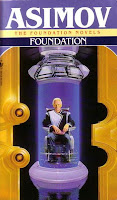
Some books feel like friends from the very beginning. Such is the case with Isaac Asimov's novel, Foundation. This book was originally the first in a series of Foundation novels. (However, Prelude to Foundation has since been published.) The novel is composed of five sections. Four of these sections were originally published separately and appeared as short stories in Astounding Magazine between 1942 and 1944. They were later compiled together into one volume in 1951 alongside a newly written introduction section, and thus Foundation as we know now it was published. (Does any of that matter? Not really. I didn't read the details on the publishing history until after I read it. But as an after note, I was intrigued by it. So I thought I'd share it with you.)
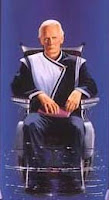 For twelve thousand years the Galactic Empire had ruled supreme. Now it was dying. But only Hari Seldon, creator of the revolutionary science of psychohistory, could see into the future--a dark age of ignorance, barbarism, and warfare that would last thirty thousand years. To preserve knowledge and save mankind, Seldon gathered the best minds in the Empire--both scientists and scholars--and brought them to a bleak planet at the edge of the Galaxy to serve as a beacon of hope for future generations. He called his sanctuary the Foundation.
For twelve thousand years the Galactic Empire had ruled supreme. Now it was dying. But only Hari Seldon, creator of the revolutionary science of psychohistory, could see into the future--a dark age of ignorance, barbarism, and warfare that would last thirty thousand years. To preserve knowledge and save mankind, Seldon gathered the best minds in the Empire--both scientists and scholars--and brought them to a bleak planet at the edge of the Galaxy to serve as a beacon of hope for future generations. He called his sanctuary the Foundation.
But soon the fledgling Foundation found itself at the mercy of corrupt warlords rising in the wake of the receding Empire. Mankind's last best hope was faced with an agonizing choice: Submit to the barbarians and be overrun--or fight them and be destroyed.
What can I say about Foundation without giving too much away? It is one of those rare books where it's best not to know. Best not to have preconceived notions of what it's all about. Best not to think too much about what it's saying and where it's going. It's best to just go along for the ride on this one.
The settings? Various planets. The characters? Too many to list. The plot? Complex but not difficult to follow. Each section of the book is separate from the whole. Most are divided by time. Between sections, thirty years, eighty years, fifty years, a hundred years could have passed. The reader picks up hints here and there about how much time has gone by. But this isn't a book where you follow characters around. This is more of a novel where ideas play the leading role.
If there is a cohesive theme to the novel it is manipulation. Whether passive or aggressive, Foundation is all about power struggles, manipulations, and getting others to do what you want when you want. It is all about ambition.
Do not look at this chart unless you want to confuse yourself. (Or you've read a good many of the books already.) For plot summary of the first novel, click here. For more information on the series as a whole, click here.

The Diaries of Adam & Eve Translated by Mark Twain. Illustrated by Michael Mojher.
This compilation combines several writings by Mark Twain. It weaves together the texts of both Adam and Eve's diaries. You can see snippets of both here and here. (Adam first, then Eve.)
One of the reviews I read notes that, "The Diaries of Adam and Eve contains a good sample of Twain's wry humor and his observations on the human condition. He portrays Adam as a man who would as soon sit around and do nothing, but whose curiosity eventually gets the better of him once it is sparked by Eve. Eve is seen as a curious woman who wants to understand everything around her and has the need to share it with any person who will listen, limited, at first, to Adam, who is passably indifferent to Eve and her passions." Another calls it a "spoof" of the creation story in Genesis. While it's true that it is slightly irreverent, I see it as capturing the bewilderment and awe of life as it might have been. It's not like there was an instruction manual. And their confusion, curiosity, and naive wonder at things we take for granted make for an enjoyable, funny, lighthearted read. At its simplest it is a funny look at how humans learned to be human. One of the more humorous sections is on how they became parents. Eve seems to "get" the baby thing more than Adam ever does. Anyway, I don't want to give too much away. But it is a short, simple, sweet book that I'd consider a must-read at some point in your life. I agree with the Amazon reviewer who wrote, "If there is a shorter, funnier, more delightful book on the planet, I have yet to find it. The genius that was Twain's is in abundant evidence here."

The Cardathon Challenge now has a banner for you to post on your site if you so desire. A big thank you goes out to Foxy Writer.
To those unfamiliar with this challenge, it does have its own blog. But I'll post a little intro here as well...
When does the challenge begin? Officially, January 1, 2008. Unofficially, whenever you want to start reading and reviewing!
What books are eligible? To qualify for the Cardathon Challenge a book needs to meet one of the following criteria:
1) a book written by Orson Scott Card
2) a book edited/compiled by Orson Scott Card
3) a book with an introduction by Orson Scott Card
4) a book reviewed by Orson Scott Card on his official website.
How many books are we talking about? I'd suggest choosing 6-12 books to read. Along with alternates, of course. Always feel free to list more alternates than 'official' choices. Essentially, you could read as many or as few as you wanted. Although, I hope that given a year, you would read at least six books. If you should read all the books on your list, feel free to add more.
How many books must be written by Card? I'd hope that you would choose at least one or two books for your list. But you can choose many other authors as long as they've been mentioned and/or recommended by Card. This leaves the selection process very open-ended, and gives you many, many options.
Do I have to be a sci-fi fan? No. You can be a newbie to the field. (Or a devoted fan.) Prior experience is not required. If you're a fan of realistic fiction, science fiction, fantasy, historical fiction, young adult fiction, mysteries, horror, etc. I really truly believe there is something for everyone to enjoy! Card has reviewed lots of adult books, many young adult books, a few picture books, and even a few board books. So there is truly something for everyone.
 Do I have to be an Orson Scott Card fan? No. Not necessarily. You can be a newbie and be trying Orson Scott Card for the first time.
Do I have to be an Orson Scott Card fan? No. Not necessarily. You can be a newbie and be trying Orson Scott Card for the first time.
But how will I know which books are eligible? I have listed the books meeting the first three criteria in the sidebar. I will be sorting through his review columns in the days and weeks leading up to the official start date. I will be making individual posts about those books. So looking in archives will give you a list of those. Feel free to go to his site and search for yourself if you like. And feel free to choose books that fulfill other challenges you're already participating in!
Once I make my list, can I change my mind? Yes. You can change your mind at any point. Card will keep reviewing books in his weekly column as the months go by (now-December 2008) and you can always change your list to incorporate new titles. Also, always feel free to abort a book. If you've started a book and it's not just working for you, by all means abandon it in favor of something else! No use suffering through a book because you feel it's 'required' because it's on your list.
To join the challenge, you'll need to go to the
other site and sign up via comments or Mr. Linky.

Empire by Orson Scott Card, 2006.
I read this book for the Cardathon challenge and the R.I.P. II challenge. I have mixed views on this one. It's not that I disliked it, I didn't. But I didn't love it. The characters, well, I liked them. But this was more about premise than action or characters. (There was plenty of action, believe me, but you never forgot that it was action based on a certain premise.) Politics. Media. Scary subjects for those liking to remain neutral observers of the world around them. The novel is about the polarization of America into red and blue. Conservative and liberals. Republicans and Democrats. Radical views. Strict dogmas. Plenty of rhetoric and media coverage. No middle ground. The situation in this future-America is bleak. The country is divided--strongly divided. There are people--hundreds of thousands if not millions--that hate the President and his particular party. Congress is divided as well. These two parties are always at ends with one another. Can't see eye to eye on anything. Determined to disagree on even the smallest issue. Compromise is never an option. They fight and bicker over everything. In this charged environment, a few men in the military are working on a secret secret project. A project that leads to a destructive climax. Well, not a climax so much as an opening premise. Reuben Malich--Major Malich--is working on a top-secret project that supposedly came directly from the White House. He's supposed to write up a plan on how to assassinate the President, so that they can then work on ways to prevent such an attack. He's playing devil's advocate if you will. He's supposed to think like a criminal and find the weaknesses in the system. The problem? He's being used--set up--by the bad guys. His plans become the plan that actually works at crippling the nation as we know it. The president, vice president, and secretary of defense (as well as a lot of other people) are killed--murdered. Now it is up to Reuben and his few friends--including his new assistant Captain Coleman to find out just who these "bad guys" are and uncover the whole plot. The plot is complex, not difficult to dissect afterwards, but a mystery while you're reading it. I can't really go into it here. The characters were okay for me. But none of them were developed that well. None of them were particularly strong or outstanding. The action was fast-paced. But again, it was driven by the premise of "what if????" And while the premise is arguably interesting in and of itself, I don't know that it was enough to carry the novel alone. This one had no tidy ending either. So it's one of those where you have to try to guess what would happen next. So instead of having a rather boring but satisfactory "Ah, America will be okay and everything is back to normal and just as it should be" feeling, you're left with a bit of angst. Am I glad I read it? Definitely. Did it make me think? Sure. Is it my least favorite Card novel? No. But it doesn't come close to my top ten.
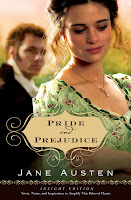
This post is going to make the rounds. It qualifies as a "Christian" read since this edition was printed by Bethany House. This "insight edition" features notes relevant to everyone, generally speaking, but has a few targeting the Christian crowd specifically. It qualifies as appealing to the young adult crowd--which means I'll be posting it on Becky's Book Reviews. It also qualifies for three challenges I'm participating in: the Something About Me challenge, the book to movie challenge, and the Cardathon Challenge.
Why did I choose to read Pride and Prejudice? I love the novel. I haven't always *loved* the novel. There was a long period of my life where I was unfamiliar with this glorious work. I knew I wanted to read it one day. But I didn't have any immediate plans to make it happen. I picked up a copy--I believe it was a Dover edition--a really cheap edition, by the way, for under three bucks. I got to it in December 2005. Years after buying the book. My motivation then? Well, my best friend, Julie, loved the book. And we were discussing the movie. (The most recent movie had just reached theaters and I wanted to go see the movie...but not until I had read the book.) I read it in probably two to four days. I devoured it really. It was just so wonderful. I was graduating with my degree in library science at the time and had some gift cards to spend, so I bought the A&E DVD version with Colin Firth. If I hadn't been convinced of its wonderfulness before, I certainly would've been after seeing the movie! I remember spending the 23rd and 24th of December watching the movie and wrapping presents and feeling all wonderfully giddy. That January, I introduced the movie to my dad. I didn't know if he would like it. It is rather long. It does have a lot of dialogue. But as soon as Mr. Collins came into the scene, Dad was hooked. That summer, June or July 2006, I introduced the movie to my sister. She was skeptical at first. She thought the first hour or so rather boring. But soon she was a fan as well. Then I introduced everyone to Bride and Prejudice. Of course, Julie was the one who first introduced ME to Bride and Prejudice...so I can't take all the credit. So there was much fun and love being spread all around in the family.
But why reread Pride and Prejudice now? Well, I saw it on the Something about Me challenge. It was tempting. But when I saw that Bethany House was releasing a special edition of the book along with their novel Just Jane by Nancy Moser--and that this edition would feature book club type questions--I really couldn't resist it. So I did request a review copy. And it came late last week. As soon as it arrived, I began reading it.
Did I discover anything new the second time around? Well, I don't know about "new" discoveries, but I certainly appreciated it more. I was able to savor it more. I knew what to expect, what was coming. I knew which bits were the "best" parts. I knew the characters. I knew their strengths and weaknesses. I love the language, the style, the romance, the characters. It really is just oh-so-magical.
For those that are unfamiliar, the plot is relatively simple. Jane and Elizabeth are the two oldest sisters in a family of five daughters. It's Regency England. Their family connections aren't the greatest, and it's really imperative that at least one or two of the daughters marry well so that they can be provided for after their father's death. Mrs. Bennet is all about getting her daughters matched up and paired off. And she's a very silly woman. Mr. Bennet is a caring father, who dotes on Elizabeth and merely tolerates the three younger sisters--who rather take after the mother. Jane is a sweet dear. Elizabeth a wit. And the book is about the complicated courtships of the two oldest children. Of course, Lydia, the youngest has her moments as the center of attention. But this isn't her story, thank goodness! Mr. Bingley, Mr. Darcy, Mr. Wickham and, of course, the unforgettable Mr. Collins play the love interests.
It's a story of love, hate, friendship, family, disdain, disgust, joy, regret, and jealousy. Lots and lots of jealousy. It is a read I recommend to everyone!
What is it about the "Insight Edition" that makes it special? It does feature notes. Mostly cultural notes--not scholarly ones. It likes to comment on the various movie versions of the book. It likes to add in tidbits about Austen's life and time. It points out that Jane is a good "Christian" girl. And it does feature discussion questions. The only thing I am disappointed about in this edition was the fact that I found four typos. One on the very first page. They misspelled first. They even misspelled his on one occasion as "vhis." This is sad, but hopefully it will be corrected with subsequent printings. Typos do happen. But all four could have easily been caught even with spellcheck, and they definitely would have been caught with a human proofreader.
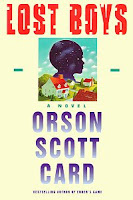
I read Lost Boys for the R.I.P. II Challenge, the Cardathon Challenge which I'm hosting, and the Read the Author Challenge. I had avoided it for years quite honestly because it is not really my kind of book. The premise is simple, what if a boy's "imaginary" friends weren't imaginary. What if they were ghosts. What if a boy's changed behavior wasn't the result of a cross-country move, what if their new house was the burial ground for kidnapped and murdered children. What if he was the only one who could see them, hear them, talk with them. What if no one believed your story. Meet Stevie. A young boy--seven and eight--who is the 'sensitive' one in his family. Thought to be odd by his classmates, Steve's insight isn't as imaginary as folks think. The oldest child--with two younger siblings and another on the way--the year of 1983 is a living nightmare. His father, devastated by the economic recession gets a job as a writer of computer manuals. He was a game programmer. A rather successful one. The mother is lost in taking care of her children and busying herself with church work. Neither is quite aware of the dangers that await them in this small town in North Carolina.
It's an uncomfortable read that never gets any easier. Why? It paints the horrors of humanity--the depravity of man--in a thoroughly realistic and haunting way. Though there is 'one' main threat, the sickness and cruelty of the human race surround this family. The coworker who is a bit too insistent on babysitting. The teacher whose cruelty is just unspeakable. The neighbor who is quite possibly certifiably crazy yet off his medication. And then there is the serial killer/child molester. This seemingly "normal" and "safe" neighborhood is anything but. And that is what makes Lost Boys so scary. The fact that even though these are cautious parents who want only the best for their children, in some ways they are helpless to protect them. It is what you don't know that may come back to haunt you when all is said and done.
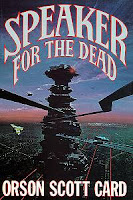
Speaker for the Dead by Orson Scott Card.
Speaker for the Dead is the sequel to Ender's Game by Orson Scott Card. But in many ways, it is even more instrumental than Ender's Game. You see, Ender's Game started out as a story--a short story. Orson Scott Card was working on ideas for a new novel, and the basic premise of Speaker for the Dead came to him. Although, at the time the Speaker was a Singer. He thought and worked and thought and worked. And then it came to him, what if the Speaker was Ender! What if he used one of his *old* characters, and gave him a new story. There was one problem. The story needed to be fleshed out before this new novel could work. And it needed more "fleshing" than just a simple prologue or chapter could do. What he needed was to turn his original story into a novel all its own. This is when the characters (we know and love) came into existence. This is when Andrew/Ender was "born."
Speaker for the Dead is a sequel, but it didn't begin life that way--and you don't have to read it that way, either. It was my intention all along for Speaker to be able to stand alone, for it to make sense whether you have read Ender's Game or not. Indeed, in my mind this was the "real" book; if I hadn't been trying to write Speaker for the Dead back in 1983, there would never have been a novel version of Ender's Game at all.
How did Speaker for the Dead come to be? As with all my stories, this one began with more than one idea. The concept of a "speaker for the dead" arose from my experiences with death and funerals. I have written of this at greater length elsewhere; suffice it to say that I grew dissatisfied with the way that we use our funerals to revise the life of the dead, to give the dead a story so different from their actual life that, in effect, we kill them all over again. No, that is too strong. Let me just say that we erase them, we edit them, we make them into a person much easier to live with than the person who actually lived.
I rejected that idea. . . No, to understand who a person really was, what his or her life really meant, the speaker for the dead would have to explain their self-story--what they meant to do, what they actually did, what they regretted, what they rejoiced in. That's the story that we never know, the story that we never can know--and yet, at the time of death, it's the only story truly worth telling.
Speaker for the Dead is the story of a planet, a colony, in need. Lusitania. Home of colonists, Catholic colonists who speak Portuguese and Stark, and home of the "Piggies", pequeninos, "Little Ones." It has been three thousand years since the close of
Ender's Game. Humans have supposedly learned much since the xenocide. They have come to regret the destruction of the Hive Queen and the "buggers" and have a new policy when dealing with alien species. This policy plays an important role in
Speaker for the Dead. The pequeninos are different--very different from the human colonists. There is a fence separating the two. Only xenologists--one or two at a time--could visit the pequeninos. Only for a few hours each day. And there were strict guidelines as to how much they could ask and tell. Pipo and Libo are the xenologists. One master, one apprentice. Novinha is the (young) xenobiologist. The three work together closely, but when tragedy strikes--Pipo's murdered by the Piggies--lives are destroyed and things are set into motion that can't be undone.
Andrew Wiggin is THE Speaker for the Dead, though only a few know it. (There are many who have that title of "speaker" but only one is the original. The author of
The Hive Queen and the
Hegemon.) When he receives the call to 'speak' the death of Pipo, he begins his journey to Lusitania...little knowing that it will forever change his life and determine his destiny.
There are many things I loved about Speaker. I love how Ender has matured into Andrew. I loved seeing how much he's grown...changed. He is wise. But his wisdom doesn't make him less human, it makes him more human. I love how this novel is about taking broken things, messy things, ugly things--and making them whole, making sense of the chaos, making them beautiful. In some ways, it is more philosophical than
Ender's Game. Again, it is the characters that make
Speaker for the Dead such an outstanding novel. His characters aren't perfect--far from it--but they're real.
Sickness and healing are in every heart. Death and deliverance are in every hand. (240)
Of all of the humans, he is the one who will understand us. (347)
When you really know someone, you can't hate them. (370)
Once you understand what people really want, you can't hate them anymore. You can fear them, but you can't hate them, because you can always find the same desires in your own heart. (370)

Harrison, Mette Ivie. 2007. The Princess and the Hound.
If you've been reading this blog long, you've probably guessed that the more I love a book, the harder it is for me to express it clearly. This book had me at hello. I mean, I was hooked from the very beginning. I was under Harrison's magic spell immediately. Her writing, her style, is just unbelievable. The Princess and the Hound reads like a fairy tale--magic spells and all. It's enchanting. It's exciting. It's ever-so-good. You'd think that with the word "Princess" in the title, it would be narrated by a girl--a princess. You would think that it would be a love story of how a princess is swept off her feet by a prince from a neighboring country and who goes on to live happily ever after. But that is not this story. It is narrated by George. A prince. The story begins when he is quite young--probably four or five--and continues through his teen years. It is a story of a kingdom in turmoil. Those with animal magic are forced to live hidden, secret lives. Accused of being "evil" and "unnatural" by their animals for being able to talk to animals and communicate with them, their very lives are at stake if they are discovered. To possess animal magic is to be condemned to die a painful death. George and his mother, the Queen, shared a secret. Both have the magic. Both hide the magic. But it was in hiding the magic, in being untrue to herself, that the Queen succumbed to a terrible fever and died. George doesn't want to die, but he doesn't want to give himself over to the magic either. He wants to control it. Hide it. Suppress it as much as possible.
So far I'm doing an absolute horrible job in sharing what this story is all about. One boy, a prince, one girl, a princess. Two kingdoms trying to keep peace. An arranged marriage. Those are the bare facts without embellishment. George and the princess, Beatrice, have their own secrets, hurts, fears, worries. Each one has reasons to mistrust others and hide their "true" selves and true thoughts and feelings. It is in this gradual revealing to one another that all unfolds and the magic released to do its healing.
Love. Loss. Pain. Confusion. Fear. Hope. Forgiveness. Compassion. Justice. This book has it all.

I promise that my obsession with H.G. Wells will not be so blatantly displayed on Becky's Book Reviews in the future. But I do have one more book left to review before it goes into effect.
When the Sleeper Wakes by H.G. Wells is a story about a man with insomnia who falls into a trance and sleeps for two hundred years. Imagine falling asleep in Victorian England, and waking up two hundred years later. Imagine the changes in society. In landscape. In politics. In everything. This is the future that Wells imagined. The Sleeper--a man named Graham--wakes up to find himself the center of attention. Not only because he's famous...but because he's wealthy. In his sleep, he has become the "master" of the world. He now "owns" most of the companies, most of the lands, etc. in the world. But is it really his for the taking? As Graham discovers, this society--this government--of sorts has secrets, lies, and propaganda. All is not as it appears. All is not as they tell him. Some sort of action on his part is required, but can he realize it in time to save the world? to save himself?
When the Sleeper Wakes definitely falls into the category of dystopic fiction. Wells' dystopia has some frightening aspects--including brainwashing and manipulation. The lower class lives in total enslavement. They live to obey. They live to serve. The middle class aren't really much better off. Most of the upper class waste their lives living it up in one of the Pleasure Cities. Only a small percent of the upper class serve as the elite and "rule" the world. Not with justice. Not with equality. But selfishly, ruthlessly, with total disregard for others. The Sleeper, Graham, wants to change all that. But can one man really make a difference? Can he be the people's messiah? Can he free the people from slavery?

Haunted by the loss of a twin she never knew and wasn't supposed to know about, Margaret Lea, the daughter of an antiques and collectibles bookseller, accepts Vida Winter's strange offer to come stay with her and hear her true story. Ms. Vida Winter is a famous--a world-famous--author. She's known not only for her excellent prose, but for her ability to spin a story--a web of lies--for the journalists and reporters that come round every time a new book is released. There are hundreds of printed stories about Ms. Winter's childhood circulating about. None of them are true. Miss Lea knows this, of course, when she goes. The invitation was so touching though--leaving words that echo down deep inside her--that Margaret just can't say no.
Preparing for her journey, Margaret immerses herself in Winter's novels. Within a matter of days, she has fallen in love with the way this woman tells a story, writes a book, crafts a narrative.
Of course one always hopes for something special when one reads an author one hasn't read before, and Miss Winter's books gave me the same thrill I had when I discovered the Landier diaries, for instance. But it was more than that. I have always been a reader; I have read at every stage of my life, and there has never been a time when reading was not my greatest joy. And yet I cannot pretend that the reading I have done in my adult years matches in its impact on my soul the reading I did as a child. I still believe in stories. I still forget myself when I am in the middle of a good book. Yet it is not the same. Books are, for me, it must be said, the most important thing; what I cannot forget is that there was a time when they were at once more banal and more essential than that. When I was a child, books were everything. And so there is in me, always, a nostalgic yearning for the lost pleasure of books. It is not a yearning that one ever expects to be fulfilled. And during this time, these days when I read all day and half the night, when I slept under a counterpane strewn with books, when my sleep was black and dreamless and passed in a flash and I woke to read again--the lost joys of reading returned to me. Miss Winter restored to me the virginal qualities of the novice reader, and then with her stories she ravished me. (32)
The story is a weaving of the past and present. Each day Miss Winter shares a little bit more of her life story. The beginning. The middle. The end. Each night Margaret is haunted not only by her day's work but by the loss of her twin. Her own family secrets. Her own hurts and pains. The story is both Miss Winter's and Margaret's. Secrets. Lies. Broken families. Ghosts. Violence. Loss. Betrayal. Love.
The Thirteenth Tale is an unforgettable read. Enjoyable from cover to cover. It's haunting. It's powerful. It's one-of-a-kind.
http://www.thethirteenthtale.com/
 Today is the first day of the Reading the Author Challenge hosted by Incurable Logophilia. This is a fairly simple and straightforward challenge. You pick an author. Any author. You choose the number of books. You choose which books. The challenge ends December 31, 2007.
Today is the first day of the Reading the Author Challenge hosted by Incurable Logophilia. This is a fairly simple and straightforward challenge. You pick an author. Any author. You choose the number of books. You choose which books. The challenge ends December 31, 2007.
My author? Orson Scott Card. My books? Speaker for the Dead. Ender's Shadow. And Pastwatch: The Redemption of Christopher Columbus. Why only three? Well, none of these are YA books. And none of them were published in 2007. So every hour I spend reading them is one hour less I have to devote to reading what I'm supposed to be reading. So three it will be for now. Perhaps, with the 24 Hour Reading Challenge coming up, hosted by The Hidden Side of the Leaf, I'll be able to knock off many on my tbr pile and I can squeeze in a few more titles. We'll have to wait and see.
The good news? This goes perfectly with my own challenge I'm trying to promote: the Cardathon Challenge. My challege begins "officially" in January. I'm finding that most people are shopping now for their new year challenges. But unofficially, my participants can start the day they join. Chris has already posted a review of one, Bridge to Terabithia by Katherine Paterson. While you're at his site, be sure to check out his post, How I Found My Favorite Author. His post is a response to my prompt on sharing your story on how you became a fan. Read mine here.
For those curious of the Cardathon rules and wondering why Bridge To Terabithia--clearly by Paterson and not Orson Scott Card is part of the challenge--then read the guidelines on eligible books.
To qualify for the Cardathon Challenge a book needs to meet one of the following criteria:
1) a book written by Orson Scott Card
2) a book edited/compiled by Orson Scott Card
3) a book with an introduction by Orson Scott Card
4) a book reviewed by Orson Scott Card on his official website.
Today, Wednesday, August 29th, 2007, is the first blogiversary for my site, Becky's Books Reviews. It is hard to believe this 'baby' of mine is one already! I am just so so so happy that everything is going so well. That people are actually enjoying my site and leaving me comments. Oh, how I love to hear feedback! Anyway, in celebration of turning one, I announced that I will be hosting a challenge--the Cardathon Challenge. This challenge has its own group blog already set up. The link is here. You can read all about the rules on that site. But know this--the rules are very relaxed. This is one stress-free, no-pressure kind of challenge where guilt isn't allowed and you can change your list as often as you want! Essentially the goal is to read a handful of books (I would recommend at least six) during the course of a year that meet these guidelines:
1) a book written by Orson Scott Card
2) a book edited/compiled by Orson Scott Card
3) a book with an introduction by Orson Scott Card
4) a book reviewed by Orson Scott Card on his official website.
The challenge "officially" starts January 1, 2008. But you can begin as soon as you want. I plan on starting this week. But again, you can join whenever you want. The challenge will go at least a year. Maybe longer. It doesn't really matter as long as people are having fun.
So today, I went to the library with this challenge in mind. That is how I am choosing my books. While I own about 70% of Card's works, there are still a few titles that I don't have. (I try to buy mine used, and it can sometimes be challenging to find used Card titles in general let alone of his newer works.) But anyway, the "book reviewed by Card" category is very large and very diverse. While many, many of these titles look tempting. I'm being guided by what my local library has already. Since my book buying budget is $0.
But these are a few I was able to find today and check out:
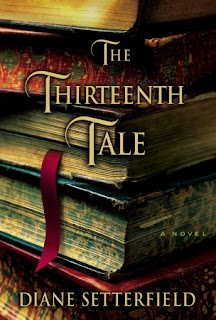
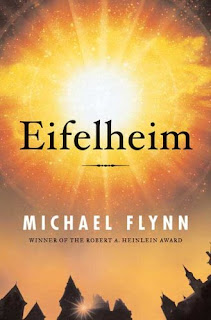




I am hosting a challenge. Yes, it's true. This challenge-addict has decided to give challenge-hosting a try! I've been thinking and thinking about this for quite a while. But inspiration finally did strike. My challenge is the Cardathon Challenge. (Though you can call it the Orson Scott Card challenge or the OSC challenge. But if you mention it on your blog, please mention that it is hosted by Becky of Becky's Book Reviews and give me a link!) It will be a challenge with its own group blog. I already set it up and have a few participants.
http://cardathon.blogspot.com/
What books are eligible? To qualify for the Cardathon Challenge a book needs to meet one of the following criteria:
1) a book written by Orson Scott Card
2) a book edited/compiled by Orson Scott Card
3) a book with an introduction by Orson Scott Card
4) a book reviewed by Orson Scott Card on his official website.
The timeframe? Ongoing. Read as many or as few books as you'd like. Participate for three months, six months, a year, or indefinitely!
What I'd love to stress is that you do NOT have to be an Orson Scott Card fan to join. No prior experience with Card or science fiction is required. It is a challenge for everyone. And with the fourth criteria being 'a book reviewed by Card' that leaves room for A LOT of books to fit in the challenge. Adult titles. Young adult titles. Children titles. All types of books--nonfiction, fiction, fantasy, mystery, horror, thriller, realistic, historical, classics, etc. There really is something for everyone here. So you really shouldn't *worry* that there won't be anything here for your particular tastes. [He even has adapted three of Shakespeare's plays, so the theatre types can join in too!]
I invite you to read all the rules--or guidelines--at the Cardathon site. And leave a comment, here or there, if you want to join in the fun.
Since this blog has an emphasis on young adult literature, I thought I'd highlight some of the possibilities that would work for this challenge:
All the Harry Potter books
Holes by Louis Sachar
Everlost by Neal Shusterman
Speak by Laurie Halse Anderson
Mira, Mirror by Mette Ivie Harrison
Princess and the Hound by Mette Ivie Harrison
The Thief; Queen of Attolia; King of Attolia by Megan Whelan Turner
Here There Be Dragons by James A. Owen
Peter and the Starcatchers by Dave Barry
Fablehaven by Brandon Mull
Charlotte's Web by E.B. White
Bridge to Terabithia by Katherine Paterson
Fairest by Gail Carson Levine
Ella Enchanted by Gail Carson Levine
All of David Lubar's books
Invention of Hugo Cabret by Brian Selznick
The dangerous book for boys, Iggulden
and many, many more. If memory serves me...Shannon Hale's books would be eligible too.
My challenge would also work well in combination with these challenges:
2008 Themed REading Challenge
Crazy Cozy Murder's Series Challenge
The Reading the Author challenge hosted by Incurable Logophilia.
Joy's First In A Series Challenge
Some of these challenges begin in the fall. Others begin in January or so.
 A couple of years ago a diminutive orange cat sprang into our hearts and homes courtesy of picture book creators, Alison Reynolds and Heath McKenzie. That cat was, Marmalade. He caused quite a sensation around our home, so when we heard he was on tour with Alison Reynolds, purrs of satisfaction reverberated throughout the house once more.
A couple of years ago a diminutive orange cat sprang into our hearts and homes courtesy of picture book creators, Alison Reynolds and Heath McKenzie. That cat was, Marmalade. He caused quite a sensation around our home, so when we heard he was on tour with Alison Reynolds, purrs of satisfaction reverberated throughout the house once more.
 When Toby, the boy across the road attempts to join BFFs, Ella, Maddy and Marmalade, things go instantly awry. Toby’s endeavours to fit in are not particularly successful nor welcomed by Ella and Maddy. He is over-exuberant, clumsy and dresses funny. Marmalade, however, sees him differently.
When Toby, the boy across the road attempts to join BFFs, Ella, Maddy and Marmalade, things go instantly awry. Toby’s endeavours to fit in are not particularly successful nor welcomed by Ella and Maddy. He is over-exuberant, clumsy and dresses funny. Marmalade, however, sees him differently.







 This week, leading-edge technologists, social media gurus and publishers discussed the future of publishing at the O’Reilly Tools for Change for Publishing conference.
This week, leading-edge technologists, social media gurus and publishers discussed the future of publishing at the O’Reilly Tools for Change for Publishing conference.























This is a very practical list of publishing terms which I'll recommend to my writing students.
Many 'shy' people find the 'pitch' the most difficult.
Hi Renee,
fabulous list of what's what in the publishing game.
Thanks Hazel and Karen for your comments. I'll keep adding to this list as I'm sure there's many more.